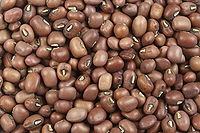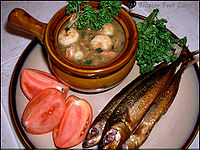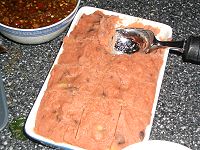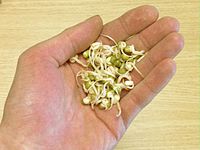- Mung bean
-
Mung bean 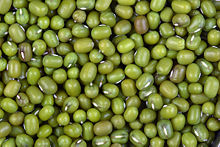
Scientific classification Kingdom: Plantae (unranked): Angiosperms (unranked): Eudicots (unranked): Rosids Order: Fabales Family: Fabaceae Genus: Vigna Species: V. radiata Binomial name Vigna radiata
(L.) R. WilczekSynonyms Phaseolus aureus Roxb.
mature seeds, raw Nutritional value per 100 g (3.5 oz) Energy 1,452 kJ (347 kcal) Carbohydrates 62.62 g - Sugars 6.60 g - Dietary fiber 16.3 g Fat 1.15 g Protein 23.86 g Vitamin C 4.8 mg (6%) Calcium 132 mg (13%) Magnesium 189 mg (53%) Phosphorus 367 mg (52%) Potassium 1246 mg (27%) Sodium 15 mg (1%) Percentages are relative to US recommendations for adults.
Source: USDA Nutrient Databaseboiled mung beans Nutritional value per 100 g (3.5 oz) Energy 441 kJ (105 kcal) Carbohydrates 19.15 g - Sugars 2.00 g - Dietary fiber 7.6 g Fat 0.38 g Protein 7.02 g Vitamin C 1.0 mg (1%) Calcium 27 mg (3%) Magnesium 0.298 mg (0%) Phosphorus 99 mg (14%) Potassium 266 mg (6%) Sodium 2 mg (0%) Percentages are relative to US recommendations for adults.
Source: USDA Nutrient DatabaseThe mung bean (also known as mungbean, mung, green gram, or golden gram) is the seed of Vigna radiata.[1][2] It is native to the Indian subcontinent.[3]
Contents
Description
They are small, ovoid in shape, and green in color. The English word mung derives from the Hindi word मूँग mūṅg (Hindustani pronunciation: [muːŋg]).
Taxonomy
The mung bean is one of many species recently moved from the genus Phaseolus to Vigna, and is still often seen incorrectly cited as Phaseolus aureus or Phaseolus radiatus.
Uses
Mung beans are commonly used in Chinese cuisine,[1], as well as in the cuisines of Burma, Sri Lanka, Thailand, Japan, Korea, Philippines, Bangladesh, Pakistan, India, Indonesia, Vietnam, and other parts of Southeast Asia. The starch of mung beans is also extracted from them to make jellies and "transparent" or "cellophane" noodles. Mung batter is used to make crepes named pesarattu in Andhra Pradesh, India.
Whole mung beans are generally prepared from dried beans by boiling until they are soft. In Chinese cuisine, whole mung beans are used to make a tángshuǐ, or dessert, otherwise literally translated, "sugar water", called lǜdòu tángshuǐ, which is served either warm or chilled. In Indonesia, they are made into a popular dessert snack called es kacang hijau, which has the consistency of a porridge. The beans are cooked with sugar, coconut milk, and a little ginger. Although whole mung beans are also occasionally used in Indian cuisine, beans without skins are more commonly used; but in Kerala, whole mung beans is commonly boiled to make a dry preparation often served with rice gruel (kanji). In the Philippines, it is the main ingredient of the dessert hopiang munggo. A savory dish called ginisang monggo (known in English as 'sautéed mung bean', 'mung bean stew', or 'mung bean soup'), also known as mongo guisado or simply balatong/monggos, is made of mung beans with shrimp or fish. It is traditionally served on Friday evenings, as the majority of the Filipino population are Roman Catholic and abstain from meat on Fridays, even outside of Lent.[citation needed] Ginisang monggo can also be made with chicken or pork.
Whole beans
Mung beans are light yellow in color when their skins are removed.[1] They can be made into mung bean paste by dehulling, cooking, and pulverizing the beans to a dry paste.[1] In Hong Kong, dehulled mung beans and mung bean paste are made into ice cream or frozen ice pops.[1] Mung bean paste is used as a common filling for Chinese mooncakes in East China and Taiwan.[1] Also in China, the boiled and shelled beans are used as filling in glutinous rice dumplings eaten during the dragon boat festival (端午节).[1]
Dehulled mung beans can also be used in a similar fashion as whole beans for the purpose of making sweet soups. Mung beans in some regional cuisines of India are stripped of their outer coats to make mung dal. In Tamil Nadu and Andhra Pradesh, steamed whole beans are seasoned with spices and fresh grated coconut in a preparation called sundal. In south and north Indian states, mung beans are also eaten as pancakes. They are soaked in water for six to 12 hours (the higher the temperature, the lesser soaking time). Then they are ground into fine paste along with ginger and salt. Then pancakes are made on a very hot griddle. These are usually eaten for breakfast. This provides high quality protein that is rare in most Indian regional cuisines. Pongal or kichdi is another recipe that is made with rice and mung beans without skin.
In Kerala, it is commonly used to make the parippu preparation in the Travancore region (unlike Cochin and Malabar, where toor dal, tuvara parippu, is used). It is also used, with coconut milk and jaggery, to make a type of payasam.
Bean sprouts
Mung bean sprouts are germinated by leaving them watered with four hours of daytime light and spending the rest of the day in the dark. Mung bean sprouts can be grown under artificial light for four hours over the period of a week. They are usually simply called "bean sprouts".
Mung bean sprouts are stir-fried as a Chinese vegetable accompaniment to a meal, usually with ingredients such as garlic, ginger, spring onions, or pieces of salted dried fish to add flavor. Uncooked bean sprouts are used in filling for Vietnamese spring rolls, as well as a garnish for phở. They are a major ingredient in a variety of Malaysian and Peranakan cuisine, including char kway teow, hokkien mee, mee rebus, and pasembor. In Korea, slightly cooked mung bean sprouts, called sukjunamul (hangul: 숙주나물), are often served as a side dish. They are blanched (placed into boiling water for less than a minute), immediately cooled in cold water, and mixed with sesame oil, garlic, salt, and often other ingredients. In the Philippines, mung bean sprouts are made into lumpia rolls called lumpiang togue.
Mung bean sprouts are the major bean sprouts in most Asian countries. In China and Korea, soybean sprouts, called kongnamul (hangul: 콩나물) are more widely used in a variety of dishes.
Starch
Mung bean starch, which is extracted from ground mung beans, is used to make transparent cellophane noodles (also known as bean thread noodles, bean threads, glass noodles, fensi (粉絲), tung hoon, miến, bún tàu, or bún tào). Cellophane noodles become soft and slippery when they are soaked in hot water. A variation of cellophane noodles, called mung bean sheets or green bean sheets, are also available. In Korea, a jelly called nokdumuk (hangul: 녹두묵; also called cheongpomuk; hangul: 청포묵) is made from mung bean starch; a similar jelly, colored yellow with the addition of gardenia coloring, is called hwangpomuk (hangul: 황포묵). In northern China, mung bean jelly is called liangfen (凉粉, meaning chilled bean jelly), which is very popular food during summer. Jidou liangfen is another flavor of mung bean jelly food in Yunnan, in southern China.
Nomenclature
Mung beans are known under a variety of names in different languages:
- Assamese: mugu dali, mogu dail
- Bengali: moog dal, moog, moong, or mongo
- Chinese: lǜdòu (绿豆, literally "green bean")
- Burmese: pe nauk (ပဲနောက်) or pe ti (ပဲတီ)
- East Timor: monggo or munggo
- Filipino: monggo or munggo
- Hindi: mūṅg (मूँग)
- Indonesian: kacang hijau or katjang idju
- Kannada: hesaru kaalu (ಹೆಸರು ಕಾಳು)
- Malayalam: moong dal, cherupayar or cheru payaru
- Marathi: moog dal, moog, moong, or mongo
- Pashto: mai (مۍ)
- Punjabi: moongi
- Sinhala: mung eta (මුo ඇට)
- Swahili: choroko
- Tamil:paccaippayaru (பச்சைப்பயறு), pāciparuppu (பாசிபருப்பு)
- Telugu: pesara (పెసర)
- Vietnamese: đậu xanh
Mung bean sprouts are known as the following:
- Burmese: pe ti pin pauk (ပဲတီပင်ပေါက်)
- Chinese: yácài (芽菜, literally "sprout vegetable"), or yínyá (銀芽, literally "silver sprouts")
- Dutch: tauge
- Filipino: togue
- Hokkien: tāu-gê
- Indonesian: tauge
- Japanese: moyashi (萌やし)
- Korean: sukju namul
- Malay: tauge
- Mandarin: dòuyá (豆芽)
- Singlish: tauge
- Sinhala: mung biija (මුo බීජ)
- Thai: thua-ngok (ถั่วงอก)
- Vietnamese: giá đậu or giá đỗ
History of domestication & cultivation
The mungbean was domesticated in India, where its wild progenitor (Vigna radiata subspecies sublobata) occurs wild.[4][5] Archaeological evidence has turned up carbonized mungbeans on many sites in India.[6] Areas with early finds include the eastern zone of the Harappan civilization in Punjab and Haryana, where finds date back about 4500 years, and South India in the modern state of Karnataka where finds date back more than 4000 years. Some scholars therefore infer two separate domestications in the northwest and south of India. In South India there is evidence for evolution of larger-seeded mungbeans 3500 to 3000 years ago.[5] By about 3500 years ago mungbeans were widely cultivated throughout India. Cultivated mungbeans later spread from India to China and Southeast Asia. Archaeobotanical research at the site of Khao Sam Kaeo in southern Thailand indicates that mungbeans had arrived in Thailand by at least 2200 years ago.[7] During the era of Swahili trade, in the 9th or 10th century, mungbeans also came to be cultivated in Africa, indicated by finds on Pemba Island.[8]
See also
References
- ^ a b c d e f g Brief Introduction of Mung Bean. Vigna Radiata Extract Green Mung Bean Extract Powder Phaseolus aureus Roxb Vigna radiata L R Wilczek. MDidea-Extracts Professional. P054. http://www.mdidea.com/products/proper/proper05402.html
- ^ "The World's Fastest Dictionary". Vocabulary.com. http://www.vocabulary.com/definition/green_gram. Retrieved 2011-06-29.
- ^ http://www.jeffersoninstitute.org/mungbean.php
- ^ Tomooka N, Vaughan DA, Moss H, Mixted N. The Asian Vigna: genus Vigna subgenus Ceratotropis genetic resources. New York: Kluwer; 2003
- ^ a b Fuller,D.Q (2007). Contrasting patterns in crop domestication and domestication rates: recent archaeobotanical insights from the Old World. Annals of Botany 100(5), 903-924.[1]
- ^ Fuller,D.Q. & Harvey,E. (2006). The archaeobotany of Indian Pulses: identification, processing and evidence for cultivation. Environmental Archaeology 11(2), 219-246 [2]
- ^ Castillo, Cristina and Dorian Q Fuller (2010). Still too fragmentary and dependent upon chance? Advances in the study of early Southeast Asian archaeobotany. In B. Bellina, E. A. Bacus, O. Pryce and J. Weissman Christie (eds.) 50 Years of Archaeology in Southeast Asia: Essays in Honour of Ian Glover. Bangkok/ London: River Books. Pp. 91-111
- ^ Walshaw, S.C. (2010). Converting to rice: urbanization, islamization and crops on Pemba, AD 700-1500. World Archaeology, 42: 137-154.[3]
External links
- "mung bean Vigna radiata". Integrated Taxonomic Information System. http://www.itis.gov/servlet/SingleRpt/SingleRpt?search_topic=TSN&search_value=506804.
- "mung bean Vigna radiata var. radiata". Integrated Taxonomic Information System. http://www.itis.gov/servlet/SingleRpt/SingleRpt?search_topic=TSN&search_value=530971.
Categories:- Vigna
- Edible legumes
- Edible thickening agents
- Philippine ingredients
- Vietnamese ingredients
- Malaysian ingredients
- Korean ingredients
- Chinese ingredients
Wikimedia Foundation. 2010.

